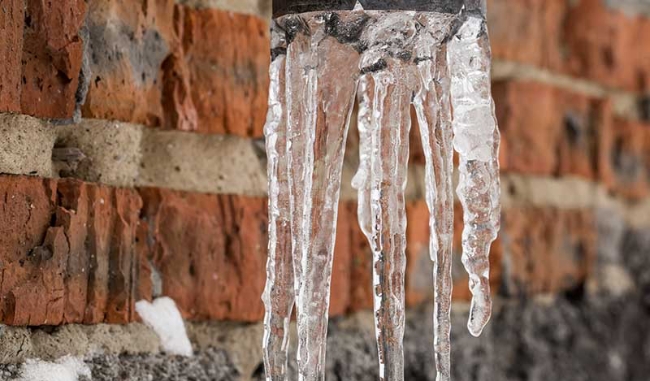Essential Methods for Avoiding Frozen Pipes in Winter
Essential Methods for Avoiding Frozen Pipes in Winter
Blog Article
Nearly everybody maintains his or her own idea on the subject of How to Prevent Your Pipes From Freezing.
:strip_icc()/snow-outdoor-faucet-pipes-4af65d1e5e904fb1aa7bf74071fe5d89.jpg)
Cold weather can ruin your plumbing, particularly by freezing pipes. Right here's how to stop it from happening and what to do if it does.
Introduction
As temperatures decline, the danger of frozen pipelines increases, potentially causing pricey fixings and water damages. Comprehending how to stop frozen pipelines is essential for home owners in cool environments.
Understanding Frozen Pipelines
What creates pipelines to ice up?
Pipes ice up when revealed to temperature levels listed below 32 ° F (0 ° C) for expanded periods. As water inside the pipes ices up, it expands, taxing the pipe walls and potentially causing them to break.
Dangers and damages
Icy pipelines can bring about water supply disruptions, residential property damages, and expensive repairs. Ruptured pipelines can flood homes and cause comprehensive structural damages.
Indicators of Frozen Water Lines
Recognizing icy pipelines early can stop them from breaking.
Exactly how to recognize frozen pipes
Search for reduced water circulation from taps, unusual smells or noises from pipes, and noticeable frost on exposed pipes.
Prevention Tips
Shielding susceptible pipelines
Cover pipelines in insulation sleeves or make use of warmth tape to shield them from freezing temperature levels. Concentrate on pipelines in unheated or exterior locations of the home.
Home heating strategies
Maintain interior rooms appropriately warmed, especially areas with plumbing. Open closet doors to enable warm air to distribute around pipelines under sinks.
Securing Exterior Plumbing
Yard hose pipes and outdoor taps
Detach and drain yard hoses prior to wintertime. Install frost-proof spigots or cover exterior taps with insulated caps.
What to Do If Your Pipelines Freeze
Immediate activities to take
If you presume frozen pipes, keep taps open up to ease stress as the ice melts. Use a hairdryer or towels soaked in hot water to thaw pipelines gradually.
Long-Term Solutions
Architectural adjustments
Take into consideration rerouting pipes far from outside wall surfaces or unheated locations. Add extra insulation to attics, cellars, and crawl spaces.
Updating insulation
Buy top quality insulation for pipelines, attics, and walls. Correct insulation helps keep regular temperature levels and decreases the threat of icy pipes.
Verdict
Preventing icy pipes needs aggressive measures and quick reactions. By recognizing the reasons, indications, and safety nets, property owners can protect their plumbing during cold weather.
6 Proven Ways to Prevent Frozen Pipes and Protect Your Home
Disconnect and Drain Garden Hoses
Before winter arrives, start by disconnecting your garden hoses and draining any remaining water. Close the shut-off valves that supply outdoor hose bibs and leave the outdoor faucet open to allow any residual water to drain. For extra protection, consider using faucet covers throughout the colder months. It’s also important to drain water from any sprinkler supply lines following the manufacturer’s directions.
Insulate Exposed Pipes
Insulating your pipes is an effective way to prevent freezing. Pipe insulation is readily available at home improvement stores and is relatively inexpensive. Pay close attention to pipes in unheated areas such as the attic, basement, crawl spaces, or garage. Apply foam insulation generously to create a buffer against the cold. You can also wrap your pipes in heat tape or thermostat-controlled heat cables for added warmth.
Seal Air Leaks
Inspect your home for any cracks or openings that could let in cold air. Seal any holes around the piping in interior or exterior walls, as well as the sill plates where your home rests on its foundation. Additionally, make sure to keep your garage door closed unless you’re entering or exiting. Leaving it open creates a significant air leak that can lead to frozen pipes.
Allow Warm Air Circulation
During cold snaps, it’s essential to allow warm air to circulate evenly throughout your home. Leave interior doors ajar to promote better airflow. Open kitchen and bathroom cabinets to help distribute heat consistently around the rooms. If you have small children or pets, be sure to remove any household chemicals or potentially harmful cleaners from open cabinets for safety.
Let Faucets Drip
A small trickle of water can make a big difference in preventing ice formation inside your pipes. When temperatures drop significantly, start a drip of water from all faucets served by exposed pipes. This continuous flow helps prevent the water from freezing. Additionally, running a few faucets slightly can relieve pressure inside the pipes, reducing the chances of a rupture if the water inside does freeze.
https://choateshvac.com/6-proven-ways-to-prevent-frozen-pipes-and-protect-your-home/

We were shown that article on Preventing and dealing with frozen pipes through an associate on our other website. For those who appreciated our blog entry if you please consider to share it. I take joy in your readership.
Make An Appointment Report this page